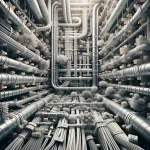In the realm of HVAC systems, cable ties play a crucial role in ensuring efficient operations and safety. But what is HVAC application, and how do cable ties contribute to this field? Let's delve into the specifics and uncover the versatile uses of cable ties in heating, ventilation, and air conditioning (HVAC) systems.
Understanding HVAC Application
In HVAC systems, cable ties are indispensable for organizing and securing wires, cables, and other components. From large industrial installations to residential setups, these ties offer a reliable solution for bundling and fastening, ensuring neatness and orderliness within the system. By maintaining proper cable management, HVAC professionals can enhance accessibility for maintenance tasks and reduce the risk of accidents or malfunctions due to tangled or loose wires.
HVAC application of cable ties extends beyond mere organization. These ties are designed to withstand the rigors of varying temperatures, moisture levels, and environmental conditions commonly encountered in HVAC environments. Whether used in ductwork, control panels, or outdoor units, cable ties provide durable support, contributing to the overall reliability and longevity of HVAC systems. With their versatile designs and materials, cable ties offer a customizable solution for securing different types of components, including pipes, hoses, and sensors, thereby optimizing the performance and efficiency of HVAC installations.
Benefits of Using Cable Ties in HVAC Systems
The adoption of cable ties in HVAC applications offers numerous benefits for both installers and end-users. Firstly, cable ties simplify the installation process, allowing for quick and hassle-free mounting of components. This not only saves time but also reduces labor costs, making HVAC projects more cost-effective. Additionally, the use of cable ties promotes a clutter-free environment, minimizing the risk of tripping hazards and facilitating easier troubleshooting and maintenance procedures.
Moreover, cable ties contribute to the overall safety of HVAC systems by preventing the movement or dislodging of critical components. By securely fastening wires and cables in place, these ties reduce the likelihood of electrical shorts or system failures caused by loose connections. Furthermore, the durability and reliability of high-quality cable ties ensure long-term performance, minimizing the need for frequent replacements and repairs. Overall, integrating cable ties into HVAC applications enhances system efficiency, safety, and longevity, making them a valuable asset for professionals in the heating, ventilation, and air conditioning industry.
Tips and Tricks for Maximizing Cable Tie Efficiency in HVAC Systems

1. Choose the Right Type
Select cable ties specifically designed for HVAC applications, ensuring they can withstand the temperature fluctuations and environmental conditions typical in heating, ventilation, and air conditioning systems.
2. Optimize Placement
Strategically position cable ties to secure wires, cables, and components, minimizing interference with airflow and allowing for easy access during maintenance tasks.
3. Use Proper Tension
Avoid over-tightening cable ties, as this can damage wires or restrict airflow. Aim for a firm but not excessive grip to maintain integrity without causing strain.
4. Consider Reusable Options
For temporary installations or projects requiring frequent adjustments, opt for reusable cable ties that can be easily released and repositioned as needed.
5. Incorporate Color Coding
Implement a color-coded system for cable ties to streamline identification and organization of different types of wires or components, simplifying troubleshooting and maintenance.
6. Invest in Quality
Choose high-quality cable ties made from durable materials to ensure long-term reliability and performance in demanding HVAC environments.
7. Conduct Regular Inspections
Periodically inspect cable ties for signs of wear, damage, or deterioration, replacing any compromised ties to maintain system integrity and safety.
8. Utilize Specialty Options
Explore specialized cable tie variations, such as UV-resistant or flame-retardant models, to address specific requirements or compliance standards in HVAC installations.
9. Train Personnel
Provide training to HVAC technicians on proper cable tie installation techniques and best practices to ensure consistent and effective use throughout projects.
10. Stay Updated
Keep abreast of industry trends and advancements in cable tie technology, incorporating innovative solutions to enhance efficiency and performance in HVAC systems.
Common Mistakes to Avoid in HVAC Cable Tie Applications
1. Overlooking Temperature Ratings
Avoid using standard cable ties in HVAC applications without considering their temperature resistance. Using ties not rated for high temperatures can lead to premature degradation and failure, compromising system integrity.
2. Neglecting Environmental Factors
Failure to account for environmental conditions such as humidity, UV exposure, or chemical exposure can result in the deterioration of cable ties over time. Ensure to select ties designed to withstand the specific environmental challenges of HVAC installations.
3. Using Improper Tension
Avoid applying excessive tension when securing cables with ties, as this can damage wires or restrict airflow. Conversely, insufficient tension may lead to loose connections or sagging wires, impacting system performance and safety.
4. Ignoring Accessibility
Failing to consider accessibility during cable tie placement can hinder future maintenance or repairs. Ensure that ties are positioned to allow easy access to components for troubleshooting or upgrades without the need for excessive dismantling.
5. Poor Cable Management
Neglecting proper cable management practices can result in tangled or cluttered wiring, impeding airflow and increasing the risk of damage or malfunction. Take the time to organize cables neatly using cable ties to maintain order and facilitate system maintenance.
6. Using Low-Quality Ties
Opting for cheap or inferior-quality cable ties may initially save costs but can lead to frequent replacements and downtime due to premature failure. Invest in high-quality ties designed for HVAC applications to ensure long-term reliability and performance.
Wrapping Up
In conclusion, the HVAC application of cable ties encompasses a wide range of functions, from organizing wiring to securing components and promoting system reliability. By leveraging the versatility and durability of cable ties, HVAC professionals can streamline installation processes, improve safety, and optimize the performance of heating, ventilation, and air conditioning systems.

